4 May 2022

In our journey towards more sustainable chemistry, it is important to learn what exactly happens in chemical processes on a molecular scale. This also counts when trying to improve catalysts, which act as facilitators for chemical reactions. ARC CBBC researcher Harith Gurunarayanan from the University of Utrecht accepted the challenge to gain more information about the activity around the catalyst on a molecular scale. In this light, he recently published his work in the journal Advanced Functional Materials.
A possible way of measuring molecular processes around catalysis is surface-enhanced Raman spectroscopy (SERS). However, to make this process work, you must apply assisting particles to the object you want to measure around. Like a camera needs a lens, SERS needs assisting particles. This is where Harith’s research comes in.
In the research that he recently published, Harith studies how these assisting particles can be made to function optimally. He uses gold nanorods, tiny cylindrical particles, as base material. These nanorods can be assembled into larger particles, so-called supraparticles, to make them more functional. A microscopic recording of such a supraparticle is shown below. Harith studied whether this supraparticle can be a useful in SERS: a lens to the molecular vibrations.
Harith indeed found that there is a potential use for the supraparticles in SERS. As it turns out, the functionality of the supraparticle can be tuned by changing the properties of the individual nanorods. This can be quite helpful when trying to reach the optimal conditions for SERS. In the time to come, Harith will use his supraparticles to study catalyzed chemical reactions.
–> Harith’s research was also featured in two other media articles! Not only on the website of the Nanotechnology World Association, but also of AZO Sensors.